Prison Work
Outline of Prison Work
1. Purpose of Prison Work
As of the end of September 2018, prison work is carried out in 76 penal institutions (prisons, juvenile prisons and detention houses) throughout the country, and approximately 42,000 people are employed. As people engaged in prison work, in addition to those sentenced to imprisonment with work under the Penal Code (Article 12 Paragraph 2) or those detained in workhouses in lieu of payment of fines, there are prisoners and detainees who are not obligated to work but may work upon request.
Prisoners work in designated fields corresponding to their own aptitude in industries such as woodworking, printing, dressmaking, metal and leather work.
3. Types of Prison Work
There are four types of prison work: production work, social contribution work, vocational training and self-employed work. Production work is divided into three categories: manufacturing work (work where all or part of the raw materials used for production are state goods), business work (work where all or part of the raw materials used for production are business goods) and provision work (work where all of the raw materials used for production are provided by the contract partner or work that the state conducts providing only the labor of inmates).
Social contribution work is work, approved by the director of the Correction Bureau, providing labor that correctional facility administrators particularly acknowledge contributes to rehabilitation and smooth reintegration because inmates feel they are contributing to society.
Vocational training is for the acquisition of licenses or qualifications by inmates, or the training to get vocational knowledge and skills.
Self-employed work is divided into accounting work (work necessary to independently run facilities such as for cooking, laundry and cleaning) and management work (work necessary for direct management such facility repairs).
4. Vocational Training
Vocational training is one of the most important measures carried out for the purpose of getting prisoners to obtain a license or qualification for an occupation or acquiring the knowledge and skills necessary for an occupation, and to prevent the recidivism of prisoners and to aid their rehabilitation.
This vocational training is being implemented systematically with the three methods of general training, group training, and self-training based on the instructions regarding the work of inmates (instructions from the Minister of Justice), and 48 varieties are being implemented in 2017 including welding, construction machinery, forklift operation, information processing technology, telecommunications equipment, barbering, hairdressing and caregiving.
5. Work Outside Penal Institutions
Prison work is usually carried out on the premises of penal institutions, but may also be carried out at a work site outside the gates with instruction and training to support the sociability of inmates.
Work outside institutions is carried out as part of what is called open treatment, and it is carried out in workplaces outside penal institutions which the facilities directly manage and operate with the understanding and cooperation of private enterprises. In addition, for work outside institutions, some require commuting to workplaces every day, and others have set up accommodations at workplace where inmates can stay.
6. Work Commuting to Business Establishments Outside Penal Institutions
With regard to inmates who meet certain requirements, they can commute to offices outside the penal institution without having the staff of the penal institution accompany them, and engage in their work or undergo vocational training.
Commuting outside penal institutions for work is a system for achieving smooth rehabilitation by regulating their behavior voluntarily based on the independence and sense of responsibility of the inmates.
7. Work Income
All income related to prison work, for which the country has signed work contracts with private companies and provides the labor of prisoners, belongs to the treasury. Prison work income for FY 2017 was approximately 3.9 billion yen.
8. Work Hours
The working hours of inmates, combined with the time for correctional instruction, is set within a range not exceeding 8 hours a day in principle.
9. Incentive Remuneration
Incentive remuneration is paid to prisoners who take part in work. As a general rule, payment of incentive remuneration is given to the person at the time of their release, but it may be used even if they are still in prison to purchase items used in their daily life in prison or to remit it to family to an extent consistent with correctional goals.
The average amount calculated per month per person for incentive remuneration in the FY 2017 budget was approximately 4,340 yen.
10. Allowance
The country takes all measures to prevent work accidents, such as taking measures in accordance with laws and regulations on occupational safety and health when conducting prison work.
However, if a worker dies due to an accident from work, we provide the bereaved family, or if the person is physically injured, the person receives compensation according to the degree of the disability.
11. Correctional Exhibitions
Penal institutions hold correctional exhibitions to gain understanding and cooperation for correctional administration. Among them, the National Correctional Exhibition (Kitanomaru Park Science Museum, Chiyoda-ku, Tokyo) sponsored by the Ministry of Justice is held every June and attracts a large number of visitors.
In addition to the content of prison sentences prescribed in the criminal code, prison work is an important treatment measure for the correction and rehabilitation of prisoners. While maintaining physical and mental health, cultivating the willingness to work, and growing inmates’ awareness of their own roles and responsibilities in communal life through letting them have a regular working life, its purpose is to promote smooth rehabilitation by giving them vocational knowledge and skills.
2. Implementation Status of Prison WorkAs of the end of September 2018, prison work is carried out in 76 penal institutions (prisons, juvenile prisons and detention houses) throughout the country, and approximately 42,000 people are employed. As people engaged in prison work, in addition to those sentenced to imprisonment with work under the Penal Code (Article 12 Paragraph 2) or those detained in workhouses in lieu of payment of fines, there are prisoners and detainees who are not obligated to work but may work upon request.
Prisoners work in designated fields corresponding to their own aptitude in industries such as woodworking, printing, dressmaking, metal and leather work.
3. Types of Prison Work
There are four types of prison work: production work, social contribution work, vocational training and self-employed work. Production work is divided into three categories: manufacturing work (work where all or part of the raw materials used for production are state goods), business work (work where all or part of the raw materials used for production are business goods) and provision work (work where all of the raw materials used for production are provided by the contract partner or work that the state conducts providing only the labor of inmates).
Social contribution work is work, approved by the director of the Correction Bureau, providing labor that correctional facility administrators particularly acknowledge contributes to rehabilitation and smooth reintegration because inmates feel they are contributing to society.
Vocational training is for the acquisition of licenses or qualifications by inmates, or the training to get vocational knowledge and skills.
Self-employed work is divided into accounting work (work necessary to independently run facilities such as for cooking, laundry and cleaning) and management work (work necessary for direct management such facility repairs).
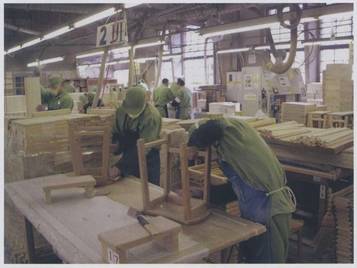 |
__ | 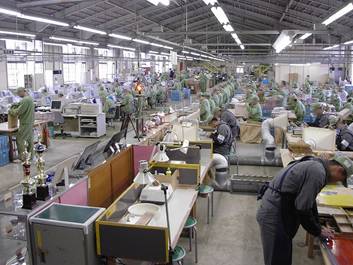 |
| Work in a penal institution | Work area inside factory |
4. Vocational Training
Vocational training is one of the most important measures carried out for the purpose of getting prisoners to obtain a license or qualification for an occupation or acquiring the knowledge and skills necessary for an occupation, and to prevent the recidivism of prisoners and to aid their rehabilitation.
This vocational training is being implemented systematically with the three methods of general training, group training, and self-training based on the instructions regarding the work of inmates (instructions from the Minister of Justice), and 48 varieties are being implemented in 2017 including welding, construction machinery, forklift operation, information processing technology, telecommunications equipment, barbering, hairdressing and caregiving.
 |
||
| Vocational training ship “Shonen Hokkai-maru” | Trainees learning navigation at the pilot-house | Measurement training in the engine room |
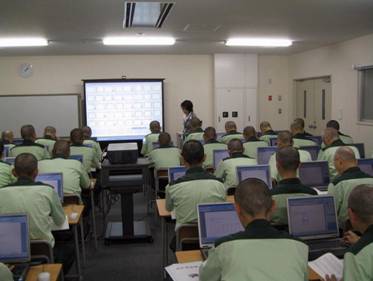 |
__ | 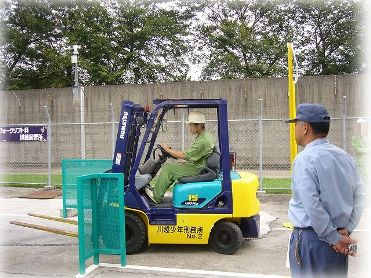 |
| Vocational training by private companies at the Mine Rehabilitation Program Center |
Forklift operation vocational training |
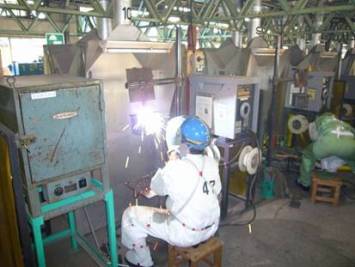 |
|
Welding vocational training |
Prison work is usually carried out on the premises of penal institutions, but may also be carried out at a work site outside the gates with instruction and training to support the sociability of inmates.
Work outside institutions is carried out as part of what is called open treatment, and it is carried out in workplaces outside penal institutions which the facilities directly manage and operate with the understanding and cooperation of private enterprises. In addition, for work outside institutions, some require commuting to workplaces every day, and others have set up accommodations at workplace where inmates can stay.
6. Work Commuting to Business Establishments Outside Penal Institutions
With regard to inmates who meet certain requirements, they can commute to offices outside the penal institution without having the staff of the penal institution accompany them, and engage in their work or undergo vocational training.
Commuting outside penal institutions for work is a system for achieving smooth rehabilitation by regulating their behavior voluntarily based on the independence and sense of responsibility of the inmates.
7. Work Income
All income related to prison work, for which the country has signed work contracts with private companies and provides the labor of prisoners, belongs to the treasury. Prison work income for FY 2017 was approximately 3.9 billion yen.
8. Work Hours
The working hours of inmates, combined with the time for correctional instruction, is set within a range not exceeding 8 hours a day in principle.
9. Incentive Remuneration
Incentive remuneration is paid to prisoners who take part in work. As a general rule, payment of incentive remuneration is given to the person at the time of their release, but it may be used even if they are still in prison to purchase items used in their daily life in prison or to remit it to family to an extent consistent with correctional goals.
The average amount calculated per month per person for incentive remuneration in the FY 2017 budget was approximately 4,340 yen.
10. Allowance
The country takes all measures to prevent work accidents, such as taking measures in accordance with laws and regulations on occupational safety and health when conducting prison work.
However, if a worker dies due to an accident from work, we provide the bereaved family, or if the person is physically injured, the person receives compensation according to the degree of the disability.
11. Correctional Exhibitions
Penal institutions hold correctional exhibitions to gain understanding and cooperation for correctional administration. Among them, the National Correctional Exhibition (Kitanomaru Park Science Museum, Chiyoda-ku, Tokyo) sponsored by the Ministry of Justice is held every June and attracts a large number of visitors.
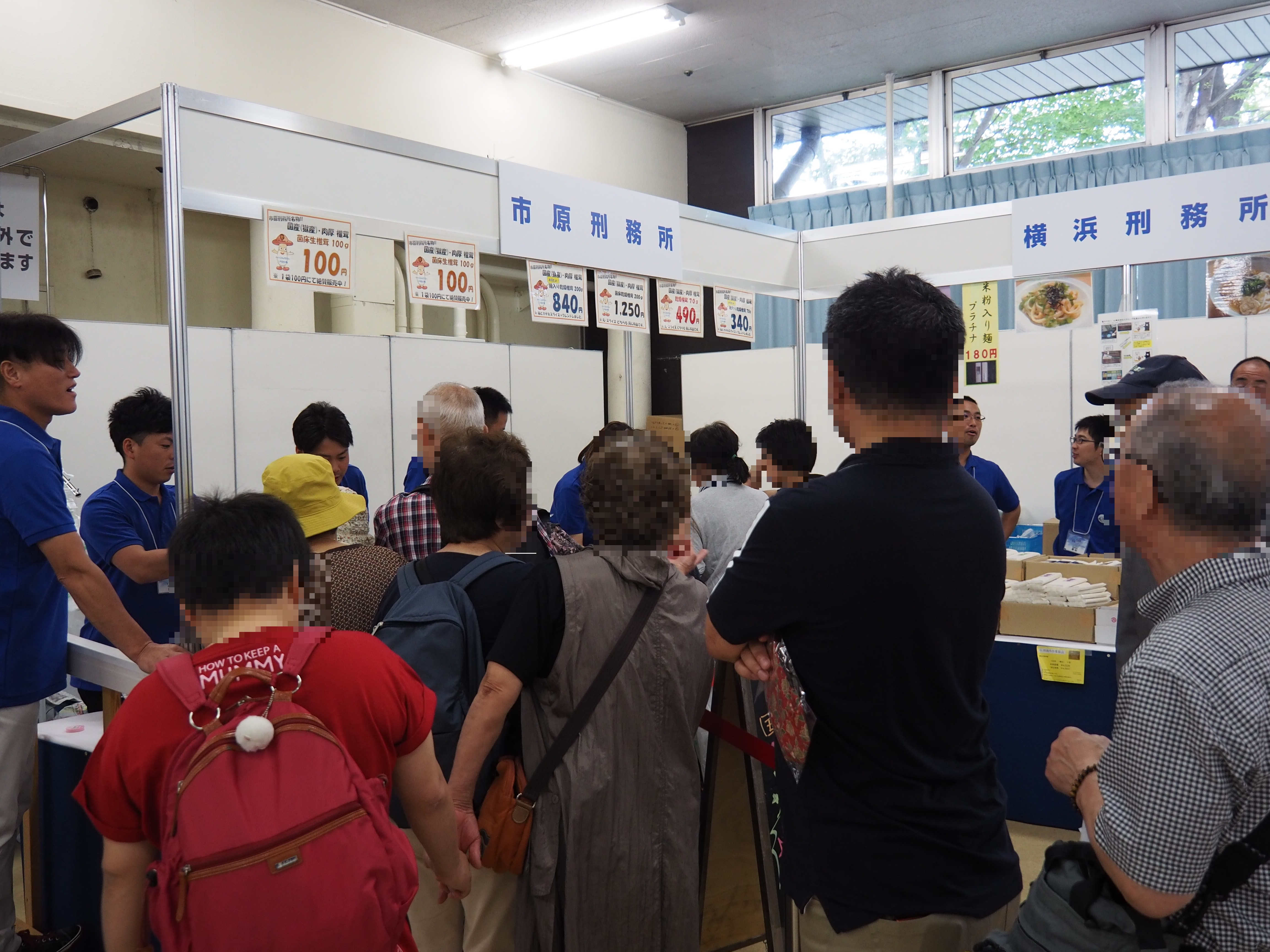 |
__ | 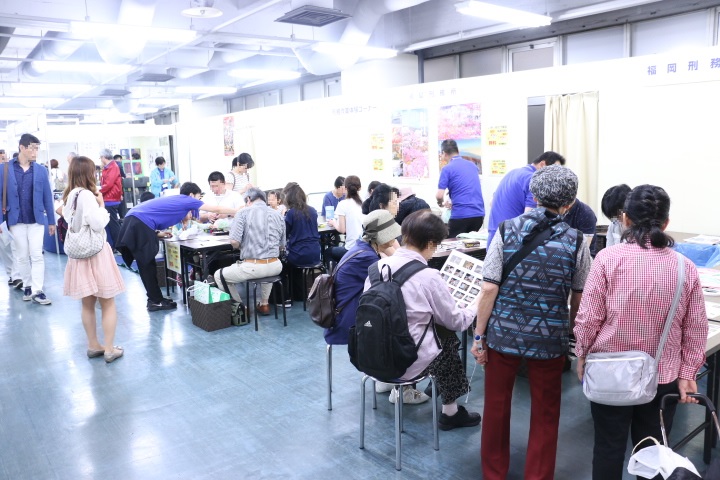 |

